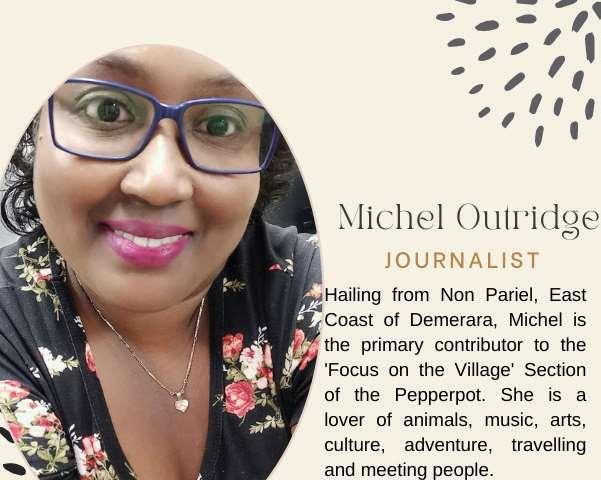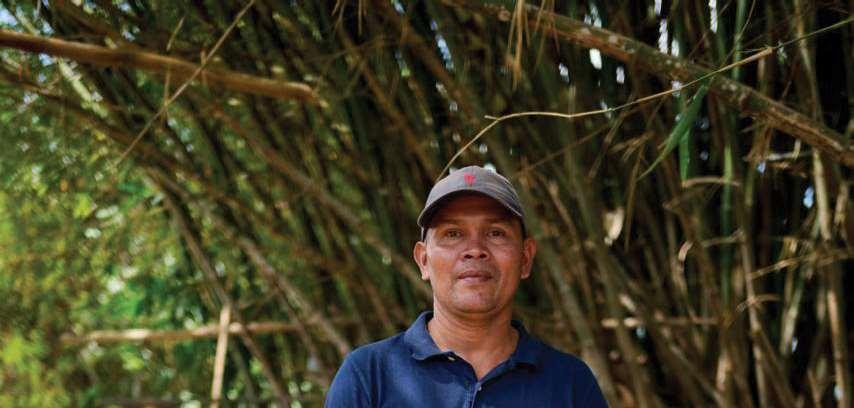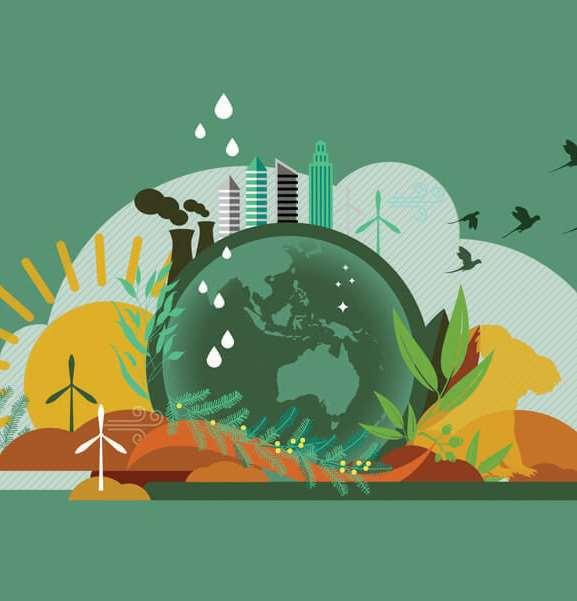




Howaboat-building programmeishelpingan Indigenous communityreconnectwith itspastwhilesailingtoward thefuture


Boatbuilderandinstructor, MitchellRogers(Samuel Maughnphoto)












MANYnailtechniciansaretrendyonsocialmedia,and IanaAshantiHercules,betterknownas“GirlBoss,”is oneofthoseprofessionalswhoisalsowell-knownamong herpeersforheruniqueskills.Amongthe‘nailgirlies’, shestandsoutbecauseshegivesyouexactlywhatyou needwithanyrequestregardingnails.
Nailartistryhasbecomemoremodern,andHerculeshas becomesomethingoutoftheordinary,withpeoplecoming upwithnewertrendsanddesignstosuittheirtastesand styles.
HerculeshashernailsalonatCroalandAlexander Streets,Georgetown,andshecanrecreateanynailinspirationfromscratch,assheiswell-versedinhercraft,having gainedexperienceandknowledgeovertheyears.
Themotherofonestartedasanailtechnicianin2007, workingatseveralsalonsinthecitybeforegoingindependent,workingfromhome,andnowrentingherownsalon pedicures,andnaildesignswithgelxextensions.
Thesedays,it’sallaboutfashion,andsomepeoplehave andwhat’strending—andHerculescaneventakeonthose challenges.
Shewillbecelebratingher35thbirthanniversarynext month,anditisherdreamtoopenherownnailschooland tohaveaseparate,standalonenailsalon.Herculesreported thatsheteachesnailcoursesmonthlyandhasbeeninthenail technicianbusinessforthepast15years.
Nailartistryisanacquiredskillthatmustbemastered overtime,andHerculeshasdoneexactlythat.Shestated that,tostayinthenailtechnicianbusiness,ithastobeforthe loveofit;youmustbepassionateaboutitinsteadofwanting tocompetewithothers.Shebelievesthatthereismoneyin thebusinessforallthosewhohaveasolidskillset.
Overtime,sheearnedthe nickname“GirlBoss”dueto herwork.Shecanrecreate anydesigntosuitacustomer’s preferences,andshehasmade anameforherselfinthenail artistrybusiness.
Whenshequalifiedand waslookingforpermanent work,shewenttotheVirgin Islandsandpractisedfortwo yearsasanailtechnicianbeforereturningtoGuyanato investandbecomeanentrepreneur.
Realisinghertalentfornail artistry,Herculesfoundaway toexpressherselfthroughher nailsalonandhasseenherself growovertime,becoming evenbetteratwhatshedoes andenjoyingeveryaspectof it.Thenailtechniciantoldthe PepperpotMagazinethatsheis aself-starterwhoismotivated bycustomersatisfactionand providingvalueformoney.
“Asanailtechnician,Igive peoplewhattheywant.What ofworkIamknownfor,and mynailslastlonger;it’sall qualitywork.Withme,youget whatyoupayfor,andkeeping businessopen,”shesaid.
Heradvicetoyoungladies hopingforaspotlightinnail artistryistofocusonthem-















nailtechnicianbusinesstobecomesuccessful.
“Thereispotentialinthenailtechnicianbusinesstobecomeself-employed,butyouhavetobeconsistent,reliable, andputoutthework.Yourworkhastobeseenandfeltby customersbeforeyoucanachieveyourgoalofsustaininga smallbusiness,”shesaid.
ForHercules,nailsarehercanvas,andshecandoany design.Sheiswillingtochallengeherselfandtestthelimits ofnailartistry.
Herculescreditshersuccesstoherlong-standing personalrelationshipwithGodandthewilltobecome thebestinnailartistry,alongwiththeneedtoadaptto trendsandmodernfashion.
PhotossavedinPhotographyfolderasIanainOctober 28,2024.
Captions:
ByMarissaV.Foster
GUYANA,liketherest oftheworld,isexposed torapidlyunfoldingtechnologicaladvancements, usingvarioustechnologies tofast-trackdevelopment. Recognisingthepotential thesedevelopmentshold, localentrepreneur,Brian Smith,isavisionarywho understandstheimportanceofnavigatingtechnologyinGuyanatocreate
HeisthefounderofDrag-tialSolutionsandcurrently holdsthetitleofOperationsLeadforthecompany. Dragonflyismorethana droneserviceprovider;the companypridesitselfasa solutionscompany,excited tofindresolutionsusing dronetechnology.
Smithdescribeshimself asa“countryboy”from Buxton,avillagewitharich legacyofresilienceandcommunityspirit.Hehasalways exploredvariousavenues inacademiaandconsiders himselfmoreofageneralist thanaspecialist.Heholdsa degreeinInternationalRelations,whichlaidthefoundationforhisengagementwith broadersocialandeconomicissues.Subsequently,he pursuedaMaster’sinNatu-
ralResourcesManagement, openingaworldofpossibilities,particularlyinGeospatialIntelligenceanddrone useinlanduseplanning.This complementedhisgrowing interestinhowtechnology canreshapeourapproaches
buteachstephasuniquely equippedmetoleadabusinessthatblendstechnology withmeaningfulsocialand environmentalimpacts.In hindsight,Icandefinitely creditmydiverseacademic backgroundfordistinctareas
widerangeofequipment. Brianhighlighteditsuse inthecurrentagricultural sector,geographyandeven nationalsecurity.Insteadof sprayingfertilisersmanually, farmerscannowusedrones tospray—savingtimeand
tomanagingandconservingnaturalresources.“My
ofsuccess”,saidSmith. organisingteamforGuytheycollaboratedwithOne CommunicationsandLunalite.Smithsharedthathis inspirationtocreateDragonpandemicandwasapivot fromtheregular‘9-5’job. “Startingfromthere,supportedbymywife,wefoundour nicheandbeganexpanding asGuyana’srealestatesector surged.Iwasabletomakea greatleapforwardafterwinningtheBlackEntrepreneurs AssociationEmancipation Pitchcompetition–whereI wontwomilliondollarsto invest,”Smithshared.
Smith’ssubsequentparticipationintheUSEmbassy YLAIProgrammealsoallowedhimtotraveltoLincoln,Nebraska,tobuildon hispitch-winningsolution. Whenaskedwhyhecommittedtodronesoverother technologicaladvancements, Smithsaid,“Dronesandrobotsarethefuture.”
Hisjourneyinthedrone sectorhasbeenfilledwith learning,growth,anda senseofpurpose.Thisleadingdronebusinessinitially startedwithonelittledrone andnowhasanexpanded
increasingproduction.Brian stressedthatmanypeople stillseedronesas“toys” ratherthanvaluabletoolsfor industry.
Smithemphasisedthat thereisstillsomemisconceptionandapprehension aboutdrones,highlighting theimportanceofeducating clientsandpartnerstoshow howdronescanimprove
remainsopentodiscussions, demonstrations,andknowledge-sharingsessionsto breakdownthesemisconceptions.Todate,thecompany’s droneshavebeenusedto helpcompleteroaddesigns, andtheyarealsocurrently workingwithlocalfarmers toapplydronestoplantprotectionandfertilisers.
Thedronetechnology
sectorisstilldeveloping, andSmithadvisesupcoming entrepreneurstofollowthe rulesoftheGuyanaCivil AviationAuthorityforsafe andresponsibleuse.Healso mentionedthatupcoming entrepreneurscanconnect ofsafety,itisimportantto
Howaboat-buildingprogrammeishelpinganIndigenous communityreconnectwithitspastwhilesailingtowardthefuture
ByShaniyaHarding.
ALLacrossGuyanachangesarehappening-with developmentinareaslike infrastructurebeingthe mostprominent.Butin communitieslikeOrealla, moresubtlechangesare happening,suchasbetter awarenessandeducation.
Oreallaisoneofseveral Amerindiancommunities thataredeterminedtodeveloptheirpeopleinthis way.
Mostrecently,theriverinecommunityofOreallahas beenleadingthewayinthis, withanumberofinteresting andcaptivatingideas.The communityhasbegunboat building,anecessarybut rareskillimplementedbythe BoardofIndustrialTraining, withinstructorsfromthe communitytakingthelocal lead.Thisinitiativemarksa significantstepforwardin preservingtraditionalskills whileadaptingtomodern needs.
MitchellRogershasbeen aboatbuilderforaslongas he’sbeenavillagerofOrealla—hisentirelife.Helearned thebasicsofboatbuilding fromhisfather,whotaught himtheartofcanoecarving. Now,yearslaterandwithdecadesofexperience,Mitchell isleadingateamofyoung meninlearningadyingskill. “Ineverexpectedmystudentswouldlearnsoquickly.Ireallyappreciatehow theycooperateandhandle things.Ioftenonlyhaveto showthemsomethingonceor twicebeforetheyunderstand theentireprocess,”hesaid.
“WhenIwasaskedifIwould betheinstructorforboat building,Ithought,‘Wow, canIreallydothis?’Ihad nevertaughtanyonebefore, butIenjoytheprocessnow. Workingwithmystudents andwatchingthemlearnhas beenveryrewarding.”
Althoughtheboat-buildingbusinessmaybealive andlucrative,traditional boat-buildingpracticesare fading.“Myfatherusedto makecanoes,butthatskill isfadinginourcommunity. Wedon’thavecanoesinour villageanymore.I’dloveto passonwhatIknowabout buildingcanoes,especially sincethey’remoredurable


thanboats.Acanoelastsfor years,whereasaboat,with constantbeatingfromthe waves,wearsoutfaster,”he explained.
Mitchellfurtheradded, “Withboats,wenowhave moderntools:planes,sanding machines,anddrills,which maketheprocesseasier.It’s whypeoplearemoreinclined tobuildboatsthancanoes nowadays.”Theshiftfrom traditionalcanoe-makingto thebroaderchangesinAmerindiancommunitiesasthey balanceculturalpreservation withcontemporaryneeds.
Forthirty-two-year-old TyrellPablo,theprogramme representsmorethanjust learningatrade.“Inever knewhowtobuildaboat, butnowIseethatthisprogrammeisveryimportant formeandothers.Everyone isgainingknowledgeand ideasonboatbuilding,”he explained.Asafisherman,
PabloseesthepracticalbenthiscoursebecauseIama
Iwanttobuildmyownboat. It’sveryexpensivetopay forone,”hesaid.Hisconcernaboutpreservingthese

skillsisalsoevident:“Ifwe don’tdosomething,wewill forgetwhatwelearned.” Theenthusiasmshownby youngparticipantslikePablo demonstratesthecommunity’scommitmenttomaintainingtheirconnectiontothe river,whichhasalwaysbeen centraltotheirwayoflife.
Beyondbuilding:creatingsustainablefutures
Fifty-four-year-oldJacobJackrepresentsanolder generationembracingnew opportunities.“I’mreally happyforthistraining.Many times,Iwantedtobuilda boatbutlackedtheexperience,”hesaid.Jacobappreciatestheaccessibilityof theprogramme.“Thingsare hardhere;attimes,youhave topayatrainertoteachyou. I’mthankfultothegovernment;weneverhadtraininglikethisbefore.”Like manyothers,heseestheprogrammeasabridgebetween generations:“Ihavechildren, andIwanttotrainthemto buildsomething.”
Whilemodernmethods mayhavereplacedtraditionalcanoecarving,the spiritofcraftsmanship, knowledge-sharing,andappreciationfortraditionremainintact.Astheseskills passfromonegeneration tothenext,theycarrywith themtechnicalexpertise andtheculturalheritage ofapeopledeterminedto navigatetheirowncourse intothefuture.
Theprogramme’simpact extendsbeyondjustboatconstruction.Thirty-four-yearoldfather,RoderickHerman, seesitasasteppingstoneto professionaldevelopment. “I’maboatcaptain,andI’m learningtobuildaboatfrom scratch,whichaddstomy trade.ThistrainingishelpingmelearnthingsInever knewbefore,”heshared.The programmealsoensuresthat itsgraduatesarecertified, somethingRoderickishappyabout.“Mostofusdon’t havealicence,andafter thistraining,we’llbeable toacquireone.It’snotjust aboutbuildingtheboatbut alsoaboutlearningtherules andregulationsoftheriver,” hesaid.ForRoderick,the “Thiswillhelpmetakebetter careofmyfamilyonceIapplywhatIlearnedfromthis training,”heexplained.His perspectivehighlightshow theprogrammeishelpingto formalisetraditionalskills withinmodernregulatory frameworks.



ByMichelOutridge
DR.SHOBARachelGobin
hasturneda15-acreplotof landatParika,EastBank Essequibo,intoafarm whereshesourcesfruits
thespaceasaprocessing facilitytoprepareanddry thefruitsbeforetheyare packagedforsupermarket shelves.
Gobin’sFarmandKitchenisafamily-ownedbusi-
andvegetablestoproduce hertrailmixandher‘Yummy’brandofdriedfruits, amongotherproducts.
Asanagro-processor, sheisenthusiasticabout promotinghealthyeating.At herOgle,EastCoastDemeraraproperty,Shobautilises
nessproducinghealthy,local snacksthataredelicious withoutaddedsugars,preservatives,oradditives.In2012, Shobacreatedaprojectthat specialisesintheproduction ofseasonaldriedfruits.Her partnersintheenterprise areherlatehusband,the
well-knowngynaecologist DrNevilleGobin,andher children.
TwoofGobin’sthree products,the‘Yummy’and ‘SquiboTrails’fruitmixes,doubleassnacksand pleasingtravelcompanions foranytripwhenhunger strikes.Thelatterisamix ofseasonalfruitswithcassavaandsweetpotato,to whichcashewnutsand peanutshavebeenadded. Theformerissimplya collectionoftastydried fruits.Thethirdproduct isapeppersauce,which Gobinhasnamed‘HotFuh So,’inkeepingwithcurrent trendylocalnames.
DrShobaGobinwasborn inMumbai,India,onDecember18,1950,andmether husband,thelateDrNeville Gobin,in1968whilehewas studyinginMumbai.The pairmarriedin1973after bothcompletedtheirMBBS degrees,andshejoinedhim inGuyanain1974.
TheGobinsreturnedto Mumbaiin1978tospecialise medicalarena.DrNeville specialisedinObstetricsand Gynaecology,whileShoba specialisedinAnaesthesia. TheythenreturnedtoGuyanatopractise.
Thecoupleareparentsto aremedicaldoctorsliketheir parents,whiletheothertwo haveaPhDinEconomics andanMScinScienceEducation,respectively.
In2011,whilecontemplatingretirement,theGobinsacquireda15-acreplot inParika,anditwasnamed Gobin’sFarmandKitchen afterbeingregisteredin 2012.Shobaexplainedthat
thefarmwaswell-organisedwhenpurchased,with grovesoffruittrees,includingmangoes,oranges, limes,cashews,sapodillas, andmanyothers,includingrambutanandcocoa, thoughmanytreesrequired caretorestoretheirproductivity.
RealisingthatParika, EastBankEssequibo,was reputedforsweetpineapples andhotpeppers,theGobins decidedtoplantboth,not realisingtheywouldhave tocopewiththeabundance whilethemarketalsofaced aglut.
AccordingtoShoba,their venturebeganwiththepurchaseof300pineappleseedlingsfromaParikafarmer.
Within18months,theyhad harvestedmorethan1,000 pineapplesand,withsuchan abundance,wereatalossas towhattodo,giventhealreadysaturatedlocalmarket.
“Thus,westartedour dehydratedfruitproject andnamedit‘Yummy’— theHealthySnack.Itis completelynatural,with absolutelynoadditives. WealsohaveYummyRolls madefromfruitpulp,”she said.
Shobaaddedthatonce theybegancultivatingcassavaandsweetpotato,they createdthe‘Squibo’Trail Mix,combiningcassava, sweetpotato,andnuts.
“Asallofushavefulltimejobs,wehavenotven-
turedoutonalargescale,and alladvertisementisbyword ofmouth,”shesaid.
Gobin’sFarmandKitchenatParika,EastBankEssequibo,isopenforpicnics, tours,retreats,andphotoshoots,allofwhichmustbe pre-scheduled.Theyrecently hostedatourforcancersurvivors.
Shobarevealedthat thereisnoaddedsugaror preservativesinherproducts.Shesayslocalfruit hasmorethansufficient naturalflavouring.She recommendshersnacks forhealth-consciousconsumersandhopestheywill becomearegularfeaturein children’slunchbags.
ByMichelOutridge
KAYLINDuncanaspires tobecomethebestversionofherselfandhas adoptedamaturemindset totakeonresponsibility atayoungage.Sheisan entrepreneurstrivingfor abetterlifeandispavingherpathtosuccess throughhersmallbaking business.Sheistheowner ofKK’sSweetTreats,a home-basedbakery,where shebakesdelectablecinna-
monrollswithtoppings, cheesecakes,andsponge cakes.
Asacitygirl,shebalancesherpersonallife alongsideherstudentlife andincorporatesGodasa vitalpartofherdailyroutine,keepingherfocused andmotivated.Duncanisa -
aspirestobecomealawyer, inspiredbyhermother,who
The19-year-oldsaidshe doesonlinestudies,andin thetimessheisn’tresearchingordoinghomework, shedecidedtouseherfree timewiselybystartinga smallbusiness.Kaylintold PepperpotMagazinethat bakingisinhergenes;both hermotherandgrandmother arecaterers,excellentcooks, forfoodandcakes.
Shegrewupwatching thembakeand,oneday, hadasuddencravingfor






cinnamonrolls,soshemade abatchforherself.Shewas pleasantlysurprisedwhen theyturnedoutbetterthan expectedand,inashort time,werecompletelysold outamongfamilymembers.
Duncanexplainedthat shebecameexcited,anda lightbulbwentoffinher head,leadinghertostarther ownsmallbakingbusiness.
perweek.
AccordingtoDuncan, managingasmallbusiness tothehighcostofgroceries. Shebuysinbulktooffsetcostswhilekeepingher productsaffordable.“I’ve learnedtoacceptthatsomebutit’sworthitbecauseI wanteveryonetobeable
isalsoseekingjobopportunitiestogainexperienceand knowledge.
Duncanexplainedthat thehardestpartofbeing asmallbusinessowneris starting;onceitgetsgoing, thewilltoperseverecomes naturally.Sheaddedthat startingabusinesswhen youngisbetterbecause, thoughrisky,onceyouhave








KaylinDuncan,thegiftedyoungbaker
Shemakescinnamonrolls fromscratchwithtoppings likestrawberry,cookiesand cream,doublechocolate, whitechocolate,andcream cheese,alongwithsponge cakeandcheesecakewith strawberrytoppings.
tobuymyproducts,”she reasoned.
Sheaddedthatshecan keepherbusinessgoingdue tostrongfamilysupport,for whichsheisgrateful.Duncansaysshegivesmorethan sinceshewastaughtthatit ismoreblessedtogivethan toreceive.
theconfidencetotakethe
InJune2023,herlife changedasshetookonthe responsibilityoflaunching herventureintoasmallbusinesswhilealsobalancing herstudies,andherpersonal life.Herbusinesswasnamed afterherchildhoodnickname,KK,andshedecided touseitforherlogo,brand, andpackaging.Duncanadvertisesthesmallbusiness onsocialmedia,including InstagramandTikTok,and shehasthreebakingdays
“Beingasmallbusiness owneratmyageisn’teasy, butIamdisciplinedenough tomanageit.Ithasgroomed meintoamoreresponsibleerwise,”shesaid.
Withtwomoreyearsat UG,Duncanexplainedthat sheneedsastimulatingjob tostayactive,butshehas sethersightsonopening herowncosylittlebakery oneday.Duncanbelieves hercinnamonrollsare morethanclassicbecause shehasintroducedher uniquehomemadetoppings. KK’sSweet Treatscinnamonrolls
Theyoungentrepreneur, fromNorthRuimveldt, Georgetown,comesfrom anextendedfamilywithher parents,grandmother,uncle, andthreeyoungersiblings. Althoughherhobby turnedsmallbusinessisn’t it,andwithhermotto,“Love atfirstbite,”KK’sSweet
ByMichelOutridge
Dr.AndreHidar
WITHapositivemindsettobalanceworkandpersonal life,DrAndreHidar,acookingsensationonTikTok,is awell-put-togetheryoungmanwhosevideosinspireand calmhisaudience.ThedoctortoldPepperpotMagazine thathebecameobsessedwithcookingandmakingTikTok videosaboutayearandahalfago.
OriginallyfromNumberTwoVillage,EastCanje,Berbice, AndrehasbeenlivinginRegionFoursincehewasattending highschool.Aftercompletinghisinternshipasadoctor,he tolearntocook,mentoredbyhisunclewhoiswell-versedin cookingandoftencooksforweddingsandotherevents.
Andreisthesonofacanecutterwhogrewupwithmodest means.Hismother,nowretired,wasateacher.Heistheonly doctorinhisfamily,afeatmadepossiblebystrongfamily support.
HecomesfromanEastIndianbackgroundandhasfour siblings.Andrecreditshissuccesstohisparents,whomade becomingadoctor.Andregrewupwatchinghisparentscare forhisbedriddengrandparents,inspiringhimtobecomea doctortohelphisfamilyandothers.
Thedoctorsharedthatheenjoysassistingothersand ispassionateaboutbringingmedicalrelieftopeople. extrastepstoensuresheadheredtohermedicationand aproperdiet.
fromhelpingothersimprove theirhealth.
DuringCOVID-19,Andredevelopedalovefor cooking-whichhehad knownsincehewasyoung -andbeganpostingvideos ofhimselfpreparingmeals.
Heexplainedthatheconsultshisunclefortipsto ensurehe’susingtheright ingredients.Throughthese videos,hebecameknownas favouriteseasoning,which
alocalsuppliergiftedhim whenheranout.
Thedoctorisastaunch Adventistandlovestravelling.Despitehisserious-lookingface,Andreis approachable,down-to-earth, andclearabouthisgoals.Andre’smothercooksbutisn’t fondofit-however,sheisa greatbaker.Andreprepares thedailymeals,whichisa relieftohismother.
andoverwhelming,soyou
mustbalanceitwithwhat
Thoughoftentiredafter work,Andrestillcomposes himselftomakecooking videos,knowinghisviewers anticipatethem,bringinghim joyinhelpingothers.
Andrestatedthathis greatestjoyatworkisseeingpatientsrecoverandlive healthylives.Hisfavourite mealisaplateofdhal,rice, friedokra,friedfish,and coconutchoka.

INmymid-teens,ayoung ladyfriendaskedmeto accompanyhertoapriest, andthentothehospital toseeherinfamous“bad man”cousin.Ibeganto complain,butsheassured methatshehadthemoney.
“Suhwha’stheproblem withyuhbad-mancousin?” Iasked.
Shereplied,“Likesomebodypoisonheinjail.He feelthathegondead,suhhe wantfuhtalktothispriest. Yuhgotanymorequestions?”
“Nah,”Irepliedsensibly toherirritatedresponse, andwecontinuedtoourtwo destinations.
Atthehospital,Iwas toldwheretostand;nextto herscepticalbrother,completelyoutofearshot.Some otherolderrelativeswere there,andthepriest,anelderlyman,wasseatednext tothebed.Thepatientonthe nextbedquietlygotupand driftedaway.Iwaitedthere foraboutanhourormore untilherrelativeseemed tofallasleep.Shecame overtome,andsaid,“He’s restingnow,anddon’task mehnostupidness.Wegon talklater.”Ishookmyhead inhumbleagreement,and weleft.
Thesummoningofthe priestkeptmethoughtful forawhile.Iknowmyenvironment,andmenlike
thisusuallysoughtso-called spiritualguidancefromothersources,suchas‘guard rings’andsoon. Thebottomlinewith ourhumanworldisits varietyofchoiceswhen castuponthelandscape ofmyriadcircumstantial challenges.Itappearsthat noneisabovetemptation
respecttheteachingsof hisdenomination,along withtheprinciplesofhis folks,yetitwasobvioushe hadmadedecisionsoutside ofthoseteachings,asour deceptivesocialrealities mayimposeandlogically dictate.
Idownloadedapaper byBaldwinM.Wayand
ana’scolonialheritagewas steepedinracismandmarginalisation.Myexperienceshaveshownmethat onecanbeembracedata stratum,butthisdoesnot meanacceptance. Thus,rudeawakenings intorealisationcancompel onetogravitatetosubculturalorothernormsto
ly“saintly”orhonourable handswithinthecliqueone onceadmired.
Inlife,therearealways alternativesthatbeckon. Thatmanwhorequired thepriestathisdeathbed haddualinterpretations fromthosewhomIenquiredwhoreallyknew him.Hewastough,but
andinterpretthesocial environmentinwhichwe dwell.
Igrewupinaworld wheretheterm,‘Principle’,encompasseswhatis expected,andhowoneis remembered.
ortheembraceofdarkness,exceptforadiscreet few.Ourculture,indeed, shapesus.Thismanwho wantedapriestathisbedsidebeforehediedwas nodoubtbroughtupto
MatthewD.Liebermanon geneticcontributionstoculthatthenatureofsociety candevelopculturalnorms byforce.
Forexample,Guy-
facilitatetherequiredsocial regime,sometimesnotto impressthoseofpastenuponrealisingthatthesnobberyexperiencedbefore camenotfromparticular-
principled,yethehada badside.Myconclusion wasthathewashuman, andthatthehumanworld requiresboldnessand self-nurturing;acommonintelligencetoadopt
Inclosing,Irememberafavouritesaying:“I knowduhpersongood; dehgotprinciple.Ifdeh sehdehgondothat,deh gondojustduh.Ifdeh can’tmekit,dehgontell yuh;dehentgonlie,and hide.”



ILOOKEDoutmywindow,acrossthegreen,lush lawnandtheborderof floweringshrubstothe woodsbeyond,darkand mysterious.Tonight,the distanthowlofacoyote cameridingonthewind.I liketothinkofthewoods asthatdauntingislandin CostaRicaoftheJurassic Dynasty,wheremanymysteriesunfoldandclose encounterswiththefascinatingcreaturesthat walkedtheearthover70 millionyearsagohappened.
Iflickedthroughthe pagesoftheEncyclopaediaofDinosaursthatIwas reading,andmyeyecaught onthemagnanimousTyrannosaurusRex,aspecies thattrulyfascinatesme.It’s apowerfulkiller,40feet long,andchargesataspeed of20milesperhour.
MyobsessionwithdinosaursissogreatthatI havefollowedwrittenfacts abouttheirexistencetotheir extinctionfervently.Ioften wonder:willtheyeverreturn?Willtherebeaworld againwheredinosaursrule? Isthere,perhaps,afossil somewherefromwhichscientistscanextractDNAand recreatethem?
Iwenttobedembracing thatthought,sayinggoodnighttotheminiatureT-Rex besidemybed.Itwaslate; thequartermoonhadslipped behindsomeclouds,andthe twinklingstarswerelike bejewelledsentriesinthe darksky.Withinthewoods,scendoasitcamenearer, andthenfromnowhere,as thoughpartoftheskyhad fallen,aloudgrowlshook theveryfoundationofthe house.Istumbledoutofbed andlookedaroundwildly.
“Whatishappening? Mum,Dad!”Iscreamed, rushingintotheirroom.
Theyweresleeping peacefullyasever.Iran acrosstomysister’sroom, andshetoowasinslumber, nestledamongherBarbie Dolls.Icreptdownthestairs
cautiously,wondering, “WhydidIalonehear this?Whatisit,analienship maybe?”
Idaredmyselftolook outthekitchenwindow, andwhatIsawmademy bloodfreeze.Standingin mybackyardwasaT-Rex, asmassive,alive,andrealas youcouldimagine.
“OhmyGod,”Imut-
life.TheSauropods,those giantplanteaters,thelargestdinosaursevertolive onland,werethere.The Brachiosaurus,oneofthe “Giraffes”ofthedinosaur world,itsneckreachingup too.
tered,“It’snotChristmas yet.Ididn’taskSantafora liveT-Rex.”
Itlowereditsheadtowardsme,lungingalittle, andbeforeIknewwhatwas happening,Iwassliding downitsback,holdingon fordearlife.Asitstrode throughthewoodsingiganticstrides,treesandsaplings felllikeragdolls.Thewind whistledshrillyinmyears, andIthoughtIhearditsay, “Whereareyougoing,little boy?”
Iwasn’tsureifitwas talkingtome,andagreat feelingoffearenteredmy racingheart.SupposeIcannotreturnandmaynever seemyfamilyagain?Then, magically,Ifoundmyself inastrangeland,aland ofhugemountains,expansiveruggedlandscapes,and standsofconifer,maple, andbeechtrees–aland Ihadseenmanytimesin documentaries,alandofthe MesozoicPeriod. Ittookmybreathaway, andfeartookanosediveas Imarvelledatthesightof theseamazingcreatures.All myimaginingshadcometo
Itwasawesome.And theDiplodocus,theten-ton beast,stoodtherewithitstail stretchingoutforup toforty-sixfeet.They wereallintheirown habitats.TheT-Rex narrowlake.Onthe othersidewasasmall flockofPterosaurs, whichhadstoppedon theirlifelongjourney todrinktheprecious water. Suddenly,from nowhere,threeraptors,swift,vicious, anddeadly,attacked totakeflight.The T-Rexroaredinaggressive defence,andIfellhardon theruggedground.Theraptorscrossedthelakeinleaps andbounds,andabattle ensuedbetweenpredators andprey.Iscrambledinto aclumpofconifertrees andcamefacetofacewith ayoungraptor.Itnudged meontothegroundand openeditsdeadlyjaws.I screamed,knowinganysecondIwouldbeeaten,but theT-Rexcrusheditinits mightyjaws,andtheother raptorswiselyretreated,not chancingafurtherbattle withthiscolossalcreature.
Thejourneycontinued, andIwasstartingtoget forwhenIopenedmyeyes, Iwasinbed,andeverythingaroundmewasnormal again.Irantothewindow, butwhatdidIexpecttosee? NotaT-Rexinmybackyard. Itwasalladream,butwhat adream!Ipattedmymini T-Rexonitsheadandwhispered,“Thankyou.”
AsIclosedthedoor, IthoughtIheardasoft growl.

HAVEyoueverwitnessedsomethingthatincitedagreat amountofangerwithinyou?Itmayhavebeenaninci-
Ouryoungergeneration,inparticular,hasadeepbond withothermembersofsocietyduetonewtechnological tools,suchassocialmedia.Whilethishasbeenanamazing
development,ithasalsointroducedsomedownsides,as traditionalhumanconnections.
Today,wearecapableofnotjustrelatingstoriesand incidentsverballybutalsoallowingotherstowitnessthem capabilitygivesusthechancetoinvolveothersinimportant Afterall,aburdenalwaysbecomeslighterwhenshared withothers.However,thisiswherearatherstrangeproblem comesintoplay:theproblemofmisplacedjustice. enoughtomaintainitinsocietyandtohelpothersacquireit. Socialmediahasgraduallydevelopedintoatoolthatallows understandingofrightandwrong.
Videos,images,andinformationpostedontheinternet narrative.Whilefalseinformationandmiscommunication areissuesinthemselves,theycanalsoinstigateentire crowdstoengageinnegativeactionsanddiscussionsbased onincorrectinformation.
ellyinapublicplace.Youmightfeelinclinedtointervene andadvisethepersontodesist.Dependingontheseverity ofthesituation,youmayevencallthepoliceorgethelpto dealwithit.Thisiswheremostpeoplewouldstopinvolving themselves.Onceitisclearthatthevictimissafe,wewould continuewithourday.
onsocialmedia,theboundaryatwhichitisnormaltostop interveningdisappears.Peoplecannotneutralisethesituationthroughsocialmedia,sotheyinsteadbegintocarry outwhattheybelieveisjustice.Thiscanrangefromleaving withtheintentofharm.Thepersonwhopostedthevideo nolongercontrolstheirpotentiallylargeaudienceandtheir punishmentforacrimetheydidnotcommit. reallyacceptableifdirectedtowardssomeonewhoappears anotherhumanbeingshouldfaceforanactiontheymaynot haveevencommitted?Cantherulesofjusticebeallowed tofadesimplybecausetheactioniscarriedoutonavirtual platform?




IJOINEDsocialmediawhileIwasinhighschoolto connectwithfriendsandfamily,playfarmyardgames, andsharememesthatIfoundfunny.Iamsuremanyof youalsojoinedforsimilarreasons.TheolderIget,the moreIseethepowerofsocialmediathroughitswider reachandconnectivity.
DuringtheCOVID-19pandemic,Iwasoneofmany youngpeoplewhousedsocialmediatocombatmisinformationbysharingpostsandinformationfromcrediblesources. Ialsostartedtopostshort“thinkpieces”onmystatus.Prior tothepandemic,Iutilisedmyphysicalplatformsincertain projectsorspacestoadvocate.Duringthepandemic,I simplynavigatedthatadvocacythroughonlineplatforms, andthatisjustoneexampleofwhatdigitalactivismis.If you’reanavidreaderofYouthPerspective,you’dknowthat thiswriterenjoyslabellingthingsforwhattheytrulyare. Assuch,Iamheretotellyouthatadvocacyandactivism comeinmanyforms,andDigitalActivismshouldnotbe excludedfromthatlist.
Digitalactivismdoesnotonlyhappenthroughsocial media.Someactivistsutiliseonlineblogs,virtualevents, onlinegroups,andevenvirtualpetitionstohighlighttheir workorraiseawarenessonvarioustopics.Beforethedigitalageofadvocacy,fundraisershadtobedoneinperson. InsteadofplanningaBBQfundaytoraisefundsfora majorsurgery,peoplecannowsetup‘GoFundMe’pages.

Thisdoesnotlimitthenumberofpeoplewhocandonate, nordoesgeographystandasabarriertodonations.With thatinmind,IwanttoemphasisethereachthatDigital Activismcanhave.
Someactivists,likeMalalaYousafzai,canshareinformationwithmillionsofpeopleatonce.Herfollowers ofinformationsharingandconnectivity.Manyactivists understandtheirroles,butnotmanyunderstandtheirresponsibility.Whetherononlineplatformsorinperson—I urgeyoualltofact-checkyourinformationbeforesharing. Itwouldbeveryirresponsibletosharemisinformation,and itcouldalsocauseyourfollowerstomistrustyourjudgementoncertainmatters.Youshouldalsobemindfuland respectfulwhilecreatingasafespaceonline.Ihaveseen ‘advocates’campaignformen-




Manyconsumers,andindeedcitizensasawhole,haveexpressedconfusionoverthetermsclimatechange,renewableenergy,lowcarbondevelopment,andcleanenergy, whicharefrequentlymentionedinthemediabutoften writtenontheseconcepts;here,wewilltrytoexplain




Theterm‘ClimateChange’isrelativelyrecentbut describesaphenomenonplanetEarthhasexperiencedfor thousandsofyears.Partsoftheplanetthatwereoncehot havebecomecoldandviceversa,andareasthatoncesupportedlushvegetation,forests,andriversweretransformed intodeserts.TheSaharaDesertisonesuchexample.ClimateChangehasalsoledtothedestructionofcivilisations. Mohenjodaro,acivilisationasgrandasEgyptandBabylon, disappearedbecauseitsriversdriedup,itsclimatebecame hotter,anditssoilsturnedsandyandlessfertile,makingit uninhabitable.Theseancientclimatechangesweredueto naturalcausesandweregradual.
Inthepast300years,however,ClimateChangehasacceleratedmuchfasterthanbefore,primarilyduetohumananimalsurvival.Heatwavesaremorefrequent,andmany low-lyingcoasts,likeGuyana’s,andislands,suchasthe Maldives,facerisingsealevels.
Themid-18thcenturysawtheadventoftheIndustrial Revolution,wherecoaland,later,fossilfuelsbegantobe consumedtopowernewmachineryandforsocialuse.These fuelsreleasecarbondioxideintotheatmosphere,andinthe lasttwocenturies,billionsoftonnesofcarbonhavebeen exacerbatedbythedeforestationofmuchoftheplanet. Treesabsorbcarbon,soforestsaretermeda“carbon sink.”Now,governmentsandpopulationsworldwiderecognisethatClimateChangewilldegradethequalityoflife andmakepartsoftheworlduninhabitableunlessconcertedplacecoalandfossilfuelswithcarbon-freeenergysources, suchaswind,solar,andhydropower.Guyanahascommitted toamixofsolar,hydro,andgas,withhydroexpectedto becometheprimarypowersource,whileisolatedhinterland communitiesmaycontinueto usesolar.
Solarandhydroarecalled
rememberthatuserssharetheskieswithothersandshould strongadvocateforthesafeuseoftheskiesandregulatory compliance.
videhigh-qualityserviceswhileexpandingthewaysthey deliverables,wearealreadyhelpingprojectssavetimeand keepworkersoutofhazardoussituations,butweseeeven
dataanalysisanddeliversmarter,faster,andmoreactionableinsightstoourclients,”hesaid.
Smithandteamarenurturingnewtalentthroughtheir dronekidsanddronegirlsprogramme,incollaborationwith througheducationwecanensurewekeeptheskiessafe whiledeliveringsolutionsforthefuture.Ouroverarching goalistocontributemeaningfullytothemodernisationand safetyofindustriesacrossGuyana,leveragingtechnologyto makelastingimpactsinourcommunities,”hesaid.
talhealthsupportwhileusing thesameplatformstobelittleor distressothers.Yououghttobe responsible.Otherwise,youhavenorighttowearthetitleof anadvocateoractivist.
Socialmedia,whenmixedwithadvocacy,canbedraining andfrustratingattimes.Assuch,itisalsoimportanttohave yourownmentalhealth.Insocialdevelopment,digitalactivismisontherise,withmanyinternationalagenciesnow digitalactivismcanalsoturnintoapotentialcareerpath.

Whenobservingothers,mostpeoplefocusonthelower partoftheface.However,ifaperson’struefeelingsare “leaked”totheobserver,theyaremorelikelytoappearon theupperfaceandmayeasilybemissed.Studiesshowthat thelowerportionoftheface(nose,lips,andcheeks)ismore activethantheupperface(eyes,brows,andforehead)when individualsengageindeceitfulintentions.






Tobetterunderstandthebrain’srecognitionandprocessshowed50peoplelinedrawingsofhumanfacesdisplaying differentemotions ontheupperversus lowerface,including happiness,sadness, anger,fear,surprise, andneutrality.Participantsviewedthe drawingsineither theleftorrightvisualfieldandmost oftenidentifiedthe lowerfaceemotion, regardlessoftheviupperface,theydidsobestwhenpictureswereshownin However,mostcontinuedtoidentifythelowerfacialemobrain’sleftside).
Recognitionofemotionaldisplaysonthelowerface appearstobeprocessedbythebrain’slefthemisphereas partofthesocial-orlearned-emotionalsystem,whereas emotionaldisplaysontheupperfaceappeartobeprocessed inthebrain’srighthemisphereaspartoftheprimary-or communication,whichwillenhanceaphysician’sability toassesshowdiseases,suchasstrokeanddementia,alter thesefunctions.
Peoplemaynaturallyfocusonthelowerfacetoaidin speechcomprehensionduringaconversation,especiallyin noisyenvironments.Socialconventionsmayalsoplayarole, asmanyculturesconsideritunacceptabletolooksomeone directlyintheeyes,fearingthe“evileye.”Thismaybe interpretedasaggressiveorthreateningbehavioursimilar tothoseobservedincertainanimalspecies.
“renewablepower”or“clean energy”becausetheyaresuppliedbynatureanddonot producecarbonorleaveanyenvironmentalfootprints. andthepreservationofexistingforestsarecritical.In Guyana,forestsaremaintainedandprotected,servingasa carbonsinktobalanceemissionsfromoilextraction.
Guyana’sdriveagainstClimateChangeledtotheestablishmentoftheGuyanaEnergyAgency(GEA),which encouragestheuseofcleanandrenewableenergy.Dr MahenderSharma,theGEA’sDirector,hashighlighted severalachievements:30,000solarpanelswereinstalled inriverineandhinterlandhomes,eachunitequippedwith 2nine-wattLEDlamps,atwelve-wattfan,andacharger. Solarfarmsweresetup,includinga1MWfarminLinden, a1.5MWfarminBartica,anda0.6MWfarminLeguan, aswellashydropowerplantsatKumu(1.5MW)andMoco Moco(0.7MW).
Thisaccesstoelectricityhasgreatlyimprovedthe qualityoflifeinhinterlandregions.Mobilephonescan nowbecharged,schoolshaveaccesstoTVandeducational channels,andpeoplecanusetheInternet.Healthcentres electricity.
Guyana’scommitmenttorenewableenergyandforest oilextraction,givingittheproudstatusofacarbon-neutral nation.
ItisvitalforGuyanesecitizenstounderstandthese terms,asclimatechangeanditsassociatedconceptsareof growingimportancetotheirfuture.






DearStudent, Welcomedearreadingfriend. Sometimestohelpyouunderstand andevaluatetheinformationgivenin apassage,youareaskedtocompare severalpassagesonthesamesubject. Goaheadtomakementalcomparisonsbetweenwhatyoualreadyknow andtheamountofinformationeach newtextbringstoyouaswellasits possiblebias.Anyway,knowthat comparingseveraltextsisonlyone wayofsystematizingwhatusually takesplaceinyourmindwhenyou read.Bewise.
Loveyou.
A..Recognisingequivalenceand theuseofgeneralwordstocover
Reminders:
1)Asynonymisaphraseorword thathastheexactmeaningasanother phraseorwordo(ornearlythesame meaning)inthesamelanguage.For example,‘beautiful’and‘attractive’ aresynonymsofeachotherbecause theybothrefertosomeoneorsomethingthatlooksgood.
2)Anantonymisawordthat meanstheoppositeofanotherword. Forinstance,theantonymof‘wet’ maybe‘dry.’However,doremember thatawordmayhavemorethanone antonym.
Therootwordsfortheword‘antonym’arethewords‘anti,’meaning ‘against’or‘opposite,’and‘onym,’ meaning‘name.’
3)Equivalencemeansastateor factorpropertyofbeingequivalent; etc.aninstanceofthis;anequivalent. Chemistry.thequalityofhaving equalvalence.
Alsoexpressed,therelationregardingtwostatements:–ascertainif theyareeitherbothtrueorbothfalse otherwouldresultinacontradiction.
Readthepassagecarefullyand thenanswerthequestionsetafterit.
Thethrow-awayspiritorthespiritofwastefulnesshasbecomepartof Americanlifeandconsumptiononly keepsrising.Besides,accordingto theeconomists,wedependsomuch onthiswastingandbuyingthatpeoplewillprobablybeencouragedto consumeevenmoreintheyearsto comeiftheUSeconomyistoprosper.Inotherwords,thesemarketing expertssaythat‘theaveragecitizen willhavetostepuphisbuyingby nearlypercentinthenextdozen years,ortheeconomywillsicken.’ Thismeansthattheproducerof householdcommodities,i.e.atelevisomenewmeansofmakingfurther salessincenineoutoftenAmerican homesnowadayshaveonetelevision haveonetelevisionset.Hecould,for
instance,launchacampaigntoinducepeopletohave asecondTVset–oroneforeachmemberofthefamily–orhecouldproduceaTVsetsosophisticatedthat peoplewouldwishtoreplacetheiroldset.
(FromVancePackard’s“TheWasteMakers”) a)Findatleastoneinstanceofsynonym. b)Findatleastoneinstanceofantonym. c)Findatleastthreemarkersofequivalence. Whichofthesethreewords(produce(s):i)anexample; ii)arephrasingofwhathasbeensaidbefore;and iii)anequivalentexpression?
i)Asaninstanceof‘producerofhouseholdcommodities’,thewritermentions-------.
ii)Inthepassage,theword‘marketingexpert’is oneinstance(i.e.itislessgeneral)ofwhatthewriter meantwhenusingtheword‘economist’before.Therelationshipbetweentwowordscanbeshownasfollows: Nowfollowtheexampleandcompletethefollowing relationship.
Note:a)Thatpoetryisthelanguageofhuman souls,andthattheyaresincere,precise,stylishrecords ofhumanfeelingsandthinkingareamongthepraisesof writersoflineswhichcanhelpreaderstorealisehow wonderfulandexcitingitistodiscovertheworldanew. b)Connotationiswhatmeaningawordsuggests orimplies.Aconnotationincludestheemotionsor associationsthatsurroundaword.Wordspecialistssay that,forexample,theword‘independent’canmean
Readthefollowingpoemandseehowitmakesyou thenanswerthehelpfulquestionsthatfollow. Theywerelovelyinthequartzandjaspersand Asiftheyhadcreatedterrariumswiththeirbodies Onpurpose;addingsprigsofseaweed,seashells, Whitefeathers,eelbones,miniature Thousandsofbabystars.Wetouchedthem, Livingintheirattitudes.Wewoulddrythem,arrangethem.
Formseascapes,geodesics…Wegatheredwhat wecould Intheapproachingdarkness.Thenwelefthundreds of Thousandsofflawlessfive-fingeredspecimens sprawled Alongthebeachasfaraswecouldsee,allmassed Together:littlemartyrs,soldiers,artlesssuicides Inlifelongliberationfromthesea.Somany Splayedhands,thetideshoveledin.
1.Whatisthemeaningofeachofthesetermsfound inthepoem?jasper;terrariums;geodesics;artless;martyrs;splayed 2.Whydoesthepoetassociate‘terrariums’with
4.a)Whataretheconnotationsoftheword‘specimens’inline11?
11)and‘shoveled’in(line15)?
c)Howdothesewordssignalashiftinthepoet’s 5.a)Whatsounddevicesdoesthepoetuse?
b)Wherearethesedevicesusedforemphasis?